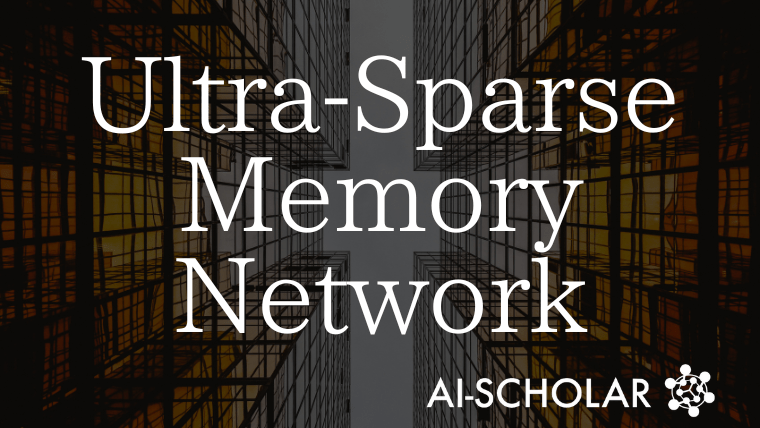
Ultra-Sparse Memory Network: A New Method To Change Transformer Memory Efficiency
3 main points
✔️ Proposed "Ultra Sparse Memory Network" to Improve Efficiency of Transformer Models
✔️ Leveraging Product Key Memory (PKM) to Improve Performance While Reducing Model Memory Access Achieved
✔️ Reduced training time and more efficient use of computational resources compared to state-of-the-art models
Ultra-Sparse Memory Network
written by Zihao Huang, Qiyang Min, Hongzhi Huang, Defa Zhu, Yutao Zeng, Ran Guo, Xun Zhou
(Submitted on 19 Nov 2024 (v1), last revised 6 Feb 2025 (this version, v2))
Comments: Published as a conference paper at ICLR 2025
Subjects: Machine Learning (cs.LG)
code:
The images used in this article are from the paper, the introductory slides, or were created based on them.
Summary
This paper proposes a new architecture called UltraSparse Memory Network. This architecture aims to improve model performance by streamlining the high memory accesses of the Transformer model. Specifically, sparse memory modules can be used to effectively extract information while reducing memory usage.
UltraSparse, in particular, provides efficient results for tasks that would require a lot of memory access in the regular model by using the vital keys directly. This allows only the necessary information to be recalled while saving other memory space.
The network also reduces memory bottlenecks that occur when dealing with large models, sometimes resulting in significant performance gains. Experimental results have shown excellent results on a variety of benchmark data sets, which will likely contribute to the efficient development of LLMs, he said.
In short, this research represents a step toward developing more efficient and scalable language models.
Research Background
This paper introduces UltraMem, an extremely sparse memory network for the Transformer model. UltraMem aims to maintain model performance while reducing memory usage. Specifically, it is designed to extend PKM (existing large memory model) to work effectively at small scales. In addition, a structure called UnitMem is proposed to make memory utilization more efficient, allowing large memory accesses with a small number of memory units. This system is supposed to increase computational efficiency while reducing the memory burden required by large models. Experimental results show that UltraMem improves performance compared to conventional models. This paper will be of interest to researchers who wish to improve the performance of their models while improving memory management.
Proposed Method
In this paper, we propose a new architecture, UltraMem, to improve the performance of the Transformer model: the Transformer model is generally capable of processing large amounts of data, but at the same time requires large memory usage. To solve this problem, UltraMem uses a new method to efficiently manage memory accesses.
UltraMem utilizes a "super sparse memory network" to reduce memory usage during training while maintaining model accuracy. Specifically, it reduces computation and training time by constraining the frequency of memory accesses. In addition, balancing memory usage and computational resources enables efficient model construction.
In addition, UltraMem expands on the existing "product key memory" (PKM) concept to provide more scalable and efficient memory management. This demonstrates the potential for training high-performance LLMs even in environments with constrained computational resources.
Experimental results show that the proposed method can significantly reduce computational cost and memory requirements compared to conventional methods, thus expanding its potential applications. This approach is a promising direction for the development of more efficient and scalable LLMs.
Experiment
In the paper "Ultra-Sparse Memory Network," a new architecture, UltraMem, is proposed to balance computational efficiency and memory usage in order to improve the performance of the Transformer model. This model combines a technique called Memory Efficient Attention Mechanism (MeE) and Prior Knowledge Memory (PKM) to achieve sparse memory access.
In our experiments, we evaluated UltraMem's performance on a large data set. In particular, we checked its performance on complex LLM-based language understanding tasks. In the experimental environment, the scalability of the model was checked by varying the number of parameters, and the computational cost was compared to that of conventional methods. Ultimately, UltraMem was shown to be more memory efficient than the conventional model and to perform equally well or better.
Importantly, UltraMem is expected to be the foundation for future LLM evolution because of its high scalability and efficient use of computational resources. This technology is particularly applicable in environments where memory and computational resources are limited.
Summary
This paper proposes a new Transformer-based architecture, UltraMem, which aims to minimize memory accesses while maintaining model efficiency. This architecture allows for training data reduction while improving performance by preserving the wide-area context. Experiments were conducted on ablation studies of different model configurations, with UltraMem showing superior performance on certain tasks.
In addition, UltraMem reduces training time compared to large language models (LLMs) while retaining some generalization capability. In particular, the combination of a multilayer perceptron (MLP) and a large memory layer allows it to operate efficiently with fewer computational resources.
As a result, UltraMem shows new possibilities for efficient and scalable language models that could help reduce computational costs in LLM training and deployment. This research could be a useful solution for those who need to process a lot of information in a short amount of time.
Categories related to this article
- Article
- Machine Learning
- Deep Learning
- Language Processing
- Expressive Learning
- Natural Language Processing
- Pruning
- Model Compression
- Natural Language Processing
- Neural Network
- Transformer
- Explainable AI
- Knowledge Distillation
- Explainable.AI
- Dataset
- Prediction
- Framework
- Language Generation
- Transfer Learning
- Large Language Models
- Model Quantization
- Computer Vision
- Optimization And Control
- Datasets








